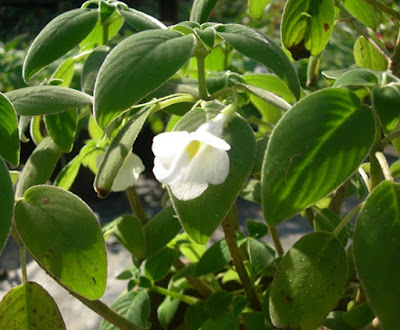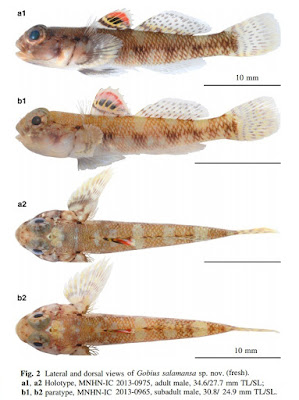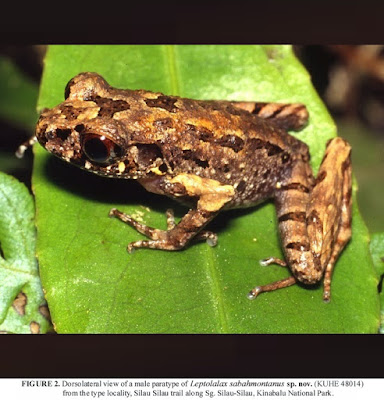[Most Recent Entries] [Calendar View]
Saturday, July 30th, 2016
| Time | Event | ||
| 8:27a | [Botany • 2016] Henckelia wijesundarae • A New endemic Species (Gesneriaceae) from Sri Lanka, and lectotypification of Chirita walkerae and C. walkerae var. parviflora
Abstract A new species, Henckelia wijesundarae, endemic to Hiniduma, Galle, Sri Lanka, is described and illustrated. Diagnostic features of the new species are discussed and compared to the closely allied species H. walkerae. Based on fieldwork studies, we propose an IUCN conservation status of Critically Endangered (CR) for H. wijesundarae. At the same time we lectotypify the names Chirita walkerae (the basionym of H. walkerae) and C. walkerae var. parviflora (treated here in the synonymy of H. wijesundarae). Keywords: Gesneriaceae, Henckelia, Chirita, Henckelia walkerae, Chirita walkerae, Chirita walkerae subsp. parviflora, Chirita walkerae var. parviflora, new species, lectotype, Sri Lanka, Hiniduma Henckelia wijesundarae Ranasinghe & Mich. Möller, sp. nov. — Fig. 3 & 4. Holotype: Sri Lanka, Southern Province, Galle District, Hiniduma, forest behind Nugagala Monastery, 208 m, 26 Jul 2013, Subhani Ranasinghe & Tharanga Wijewickrama 31 (PDA; isotypes: E, K). = Chirita walkerae [“walkeri”] var. parviflora C. B. Clarke in Candolle & Candolle, Monogr. Phan. 5(1): 112. 1883 = Chirita walkerae [“walkeri”] subsp. parviflora (C. B. Clarke) W. L. Theob. & Grupe in Ceylon J. Sci., Biol. Sci. 10: 70. 1972. — Lectotype: see p. 220. — Chirita walkerae [“walkeri”] var. “β” in Thwaites, Enum. Pl. Zeyl.: 207. 1864. Diagnosis — Henckelia wijesundarae Ranasinghe & Mich. Möller differs from H. walkerae (Gardner) D. J. Middleton & Mich. Möller by its less dense short straight hairs on the adaxial and abaxial leaf surfaces, inconspicuous hydathodes (vs prominent ones in H. walkerae) on shallowly crenulate (vs serrate) leaf margins, 8–10 pairs (vs 12–(14) pairs) of lateral veins, calyx less than 2 cm long (vs more than 2 cm long), calyx lobes keeled, with a sharp ridge along the middle axis and hairs aggregated along this ridge (vs keel inconspicuous, hairs scattered throughout calyx lobe), shorter corolla, 3–4 cm long (vs 4–6 cm long), white (vs deep purple) corolla lobes, toothed (vs un toothed) filaments, distinctly spatulate (vs cuneate-truncate) stigma, and shorter fruit, 6–7 cm long (vs 8–13 cm long). Phenology — Flowering specimens were collected from July to September; fruiting time is September to November. Distribution and ecology — Currently known from Hiniduma, Galle, in SW Sri Lanka, at altitudes of 200–300 m, growing in shade on wet rock outcrops in lowland rainforest patches. Eponymy — The specific epithet wijesundarae honours the great botanist, scientist and former Director General of the Botanic Gardens in Sri Lanka, Dr. Siril Wijesundara. Subhani Ranasinghe, Richard Milne, Rohana Jayasekara, Sumudu Rubasinghe and Michael Möller. 2016. Henckelia wijesundarae (Gesneriaceae), A New endemic Species from Sri Lanka, and lectotypification of Chirita walkerae and C. walkerae var. parviflora. Willdenowia. 46(2); 213-224. DOI: 10.3372/wi.46.46202 | ||
| 9:13a | [Ichthyology • 2016] Gobius salamansa • A New Species of Goby (Gobiidae) from the Cape Verde Islands supported by A Unique Cephalic Lateral Line System and DNA Barcoding
Abstract Gobius salamansa sp. nov., a new species of tropical eastern Atlantic goby (Teleostei: Gobiidae: Gobiinae) is described from the island of São Vicente in the Republic of Cabo Verde. With adults measuring less than 35 mm TL (total length) it is the smallest species among Gobius. It is easily distinguishable from its Atlantico-Mediterranean congeners thanks to a unique character: an additional posterior ocular head pore, newly named α’, part of the anterior oculoscapular canal and connected to pore α by a suborbital branch. The new species also possesses a rare character among gobiids: a continuous oculoscapular canal, undivided into anterior and posterior parts. The species is distinguishable from its relatives thanks to its distinctive multi-colored (white, red, black, yellow and brown) eyespot, located on the first dorsal fin; by a low number of soft rays on the second dorsal fin (11) and anal fin (9); by row r not divided into two sections; by a divided row d. The two type of specimens were collected at 0.2–0.6 m depth, at the entrance of cracks in compact volcanic boulders forming a rocky islet submerged at high tide. DNA barcoding based on COI of the species compared with sympatric gobiids and species of Atlantico-Mediterranean Gobius reveals a high nucleotide sequence divergence [Kimura’s (1980) two parameter distances of 16.5 %)], with Gobius ateriformis identified as its closest species. A dichotomous key for Gobius–Mauligobius from tropical eastern Atlantic is provided. It is the eleventh gobiid species, and the fourth endemic species, to be described in Cape Verde. Keywords: Gobiinae, New species, Eastern Atlantic, Republic of Cabo Verde, Head pore Diagnosis. The new species is characterized by a unique character among the gobiids: (1) an additional posterior ocular head pore, newly named α’, and connected to pore α by a suborbital branch of the anterior oculoscapular canal; (2) a distinctive multi-colored (white, red, black, yellow and brown) eyespot, located on the first dorsal fin. The new species is also characterised by the combination of the following characters: (1) the possession of pores on the oculoscapular (σ, λ, κ, ω, α, β, ρ, ρ1, ρ2), and preopercular (γ, δ, ε) head canals; (2) a canal section between pore ρ and ρ1 connecting the anterior and the posterior oculoscapular canals; (3) a divided row d; (4) row r not being split into two sections; (5) row x1 ending anteriorly behind pore β; (6) six transverse infraorbital rows of sensory papillae (1–6), with five anterior to the hyomandibular row b but only one above, and with the inferior sections of rows five and six well developed below row b; (7) row g ending behind row o; (8) six well developed upper free pectoral rays; (9) anterior nostril with a digitate process; (10) predorsal area and nape scaled; (11) 11 soft rays on the second dorsal, 9 soft rays on the anal fin; (12) 36–37 scales on LL; (13) a scaleless cheek and opercle. The new species also differs from close Gobius–Mauligobius relatives by the combination of the following characters: a white breast; a thin caudal peduncle, with a depth 45–50 % of caudal peduncle length; a long pectoral fin, 29–30 % of standard length; a long pelvic fin, 23–25 % of standard length; large eyes, 38–39 % of head length; a short snout, 25–26 % of head length, short interorbital width, 7.5–8.5 % of eye diameter. Distribution and habitat. — Known presently only in the Bay of Salamansa at São Vicente, Cape Verde Islands, 16.909545° N, -24.938012° W. The specimens were observed in a subtidal area at the entrance of cracks in compact volcanic boulders forming a rocky islet submerged at high tide about one hundred meters from the beach. The basaltic rocks were covered with short seaweeds and coralline algae. The habitat was largely colonized by the subtidal blenniids Ophioblennius atlanticus (Valenciennes in Cuvier and Valenciennes 1836) and Scartella caboverdiana Bath 1990. The rocky islet was surrounded by sand, rock and coral bottom, 1–3 m depth, where individuals of G. ateriformis were common under rocks. The sea temperature was 24 C at the point of collection. Etymology.— The epithet salamansa refers to the village of Salamansa, on the north of the island of São Vicente, Republic of Cabo Verde , which marks the location where the only two known specimens were collected. The specific name salamansa is proposed as a noun in apposition. Samuel P. Iglésias, Lou Frotté and Daniel Y. Sellos. 2016. Gobius salamansa, A New Species of Goby (Gobiidae) from the Cape Verde Islands supported by A Unique Cephalic Lateral Line System and DNA Barcoding. Ichthyological Research. 63(3); 356–369. DOI: 10.1007/s10228-015-0505-4 | ||
| 2:51p | [Botany • 2016] Bidoupia phongii • A New Orchid Genus and Species (Orchidaceae, Orchidoideae, Goodyerinae) from southern Vietnam
Introduction Species of subtribe Goodyerinae (Orchidaceae, Orchidoideae) in the flora of Vietnam have been the subject of a series of taxonomic treatments (Seidenfaden 1992, Averyanov 1994, 2008, Averyanov & Averyanova 2003, Nguyen, Averyanov & Duong 2005). Nonetheless, the inventory of this group remains incomplete due to their sporadic distribution, rarity in nature, and deficiency of available herbarium and living collections. Additionally, almost all Goodyera-related species rarely flower either in nature or cultivation, which makes available observations scarce. As a result, new data on species and records for the flora of Vietnam are appearing continuously (Ponert et al. 2014, Averyanov et al. 2016) in addition to the already completed accounts. One more curious novelty from Goodyerinae discovered recently in southern Vietnam is described and illustrated below. The unusual plant described here was discovered in 2010 during botanical investigations conducted by international team of botanists under leadership of Nong Van Duy, Vice Director of the Tay Nguyen Institute for Scientific Research, Vietnam Academy of Science and Technology in the northeastern part of Tay Nguyen Plateau (Central Highlands) of southern Vietnam. Phytogeographically, the largest part of this area coincides with the South Annamese floristic province of the Indochinese floristic region that is particularly rich in plant diversity and endemism (Averyanov et al. 2003). The new species is probably a local endemic of the Bidoup Range, the chain of high mountains along the border between Lam Dong and Khanh Hoa provinces in southern Vietnam. In this region, the species occurs with such typical local endemics as Arachnis annamensis (Rolfe 1905: 391) Smith (1912: 73), Vanda christensonia (Haager 1993: 39) L.M.Gardiner (2012: 49), Bulbophyllum clipeibulbum Vermeulen (2001: 51), Paphiopedilum delenatii Guillaumin (1924: 554) and Schoenorchis hangianae Averyanov & Duy (2015: 117). This species is rare and known thus far from just a single collection. It is noteworthy that the locality for this plant in primary forest is presently being seriously disturbed by road construction, logging and anthropogenic transformation. For these reasons, it is tentatively assessed as a highly endangered species due to loss of its habitat. It should be especially emphasized that this unique taxon could become extinct in the near future, and its conservation and protection needs further field investigation. Keywords: Orchidaceae, Goodyerinae, Vietnam, Bidoup Nui Ba national park, plant taxonomy, plant diversity, nature protection, Monocots, Southern Vietnam ...... Bidoupia Aver., Ormerod & Duy, gen. nov. Type:— Bidoupia phongii Aver., Ormerod et Duy. Monotypic genus endemic to southern Vietnam. Etymology:—The name to the Bidoup Mountains where the species was discovered. Generic diagnosis:— New genus allied to Dossinia, Ludisia, Macodes and Papuaea alliance, from which differs in a combination of morphological features such as black leaves (purple-brown below), flowers non-resupinate due to the ovary twisting 360°, subglobular hypochile closed by subquadrate connivent and firmly adpressed side lobes, long tube-shaped arcuate claw warty on flanges, bilobulate epichile with large wing-like lobules, lip with longitudinal internal keel rising abaxially, column with 2 large, down-directed keels as well as entire stigma, and long linear forward directed arcuate rostellum and anther cap beak. Bidoupia phongii Aver., Ormerod & Duy, sp. nov. (Fig. 1, 2) Herbaceous perennials with black leaves with white median stripe, purple-brown below. Scape shortly hairy, spike with lax spirally arranged, sessile, widely opening flowers with ovary twisting on 360°. Ovary sparsely hairy, strongly twisted. Sepals free, sparsely hairy outside; median sepal erect, lateral sepals horizontally spreading, twisted at the base. Petals oblique, connivent with dorsal sepal. Lip glabrous, trilobed, spurred; hypochile small subquadrate, closed by small quadrate side lobes connivent and firmly adpressed to each other; mesochile long, terete, strongly recurved; epichile with two large, wing-shaped, denticulate lobules; spur hemispheric, with 2 massive, stalked, clavate glands; lip inside with low longitudinal keel rising abaxially into prominent flat dent. Column short, at base with 2 large, down directed keels; stigma at front of column, entire, slightly convex; rostellum long, linear, forward directed and arcuate; anther cap with long, linear, arcuate beak. Alone species in the genus. Type:—VIETNAM. Lam Dong Province: Lac Duong district, Bidoup Ridge, primary humid, broad-leaved forest at 1526-1530 m, 12 December 2010, Nong Van Duy, VTN 1465/AL 91 (holotype: Herbarium of Tay Nguyen Institute of Scientific Research of Vietnamese Academy of Science and Technology!; isotype: LE!; cultivated and flowered in the botanical garden of Tay Nguyen Institute of Scientific Research of Vietnamese Academy of Science and Technology. Type specimen prepared from a cultivated plant, 27 August 2015). (Fig. 1, 2). Etymology:— Named in honor of Nong The Duy Phong, son of the discoverer, Nong Van Duy. Habitat, phenology and conservation status:— Creeping terrestrial herbs in primary, humid, broad-leaved and mixed evergreen forests (with Pinus dalatensis and P. krempfii) on granite. 1500–1550 m. Flowering August– September. Rare. Estimated IUCN Red List status: EN/DD. Distribution:— Endemic thus far to the type locality. Leonid V. Averyanov, Paul A. Ormerod, Nong Van Duy, Tran Van Tien, Tao Chen and Dian-Xiang Zhang. 2016. Bidoupia phongii, New Orchid Genus and Species (Orchidaceae, Orchidoideae, Goodyerinae) from southern Vietnam. Phytotaxa. 266(4); DOI: 10.11646/phytotaxa.266.4.6 | ||
| 2:54p | [Herpetology • 2014] Leptolalax sabahmontanus • A New Leptolalax (Anura, Megophryidae) from the Mountains of Sabah, Borneo
ABSTRACT A new species of Leptolalax is described from Kinabalu National Park in western Sabah, Malaysian Borneo. The new species had been assigned to L. dringi, L. gracilis, or L. fritinniens in the past. It differs from all congeners, including these species, by a unique combination of morphological characters, including small body size, rounded snout, narrower interorbital than upper eyelid, basal toe webbing, smooth skin with tiny tubercles on dorsum and dorsal side of head, small pectoral glands, absence of supraaxillary glands and ventrolateral glandular ridges, spotted venter, advertisement call consisting of long series of 1-149 notes, each composed of three or four pulses, and dominant frequency at 6.90-7.35 kHz, without prominent frequency modulation. Keywords: Amphibia, Leptolalax sabahmontanus sp. n., advertisement call, Sabah, mtDNA phylogeny Masafumi Matsui, Kanto Nishikawa and Paul Yambun. 2014. A New Leptolalax from the Mountains of Sabah, Borneo (Amphibia, Anura, Megophryidae). Zootaxa. 3753(5):440-452. DOI: 10.11646/Zootaxa.3753.5.3 |
| << Previous Day |
2016/07/30 [Calendar] |
Next Day >> |











